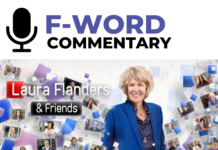Prefer to Listen?
Subscribe to our podcast to listen to this week’s episode on your favorite podcast platform (Available 9/25).
From the sinking lands of California’s Central Valley to the depleting aquifers nationwide, we’re at a critical point: Americans are running out of water. In this episode of Meet the BIPOC Press, a monthly collaboration between The Laura Flanders Show and URL Media, we take a closer look at the US water crisis that is affecting many Americans, and putting communities of color especially at risk. How are over-extraction and climate change impacting our water supply? BIPOC media outlets are bringing these stories to the forefront, debunking myths about climate change and uplifting solutions to this urgent issue. Joining us for this conversation are Warigia Bowman, Professor at the University of Tulsa College of Law, and Andrew Hazzard, Climate Reporter at Sahan Journal, which is dedicated to reporting on communities of color in Minnesota. Co-host S. Mitra Kalita is co-founder of URL Media, a national network of Black and Brown community news outlets. Kalita is also the publisher of Epicenter-NYC, a newsletter based in Queens, New York. How do we turn the tide on this crisis, before our water sources run dry?
“We should change the food and the crops we grow, we should change what we eat. We should change how we view the role of agriculture in our society . . . Indigenous people are not well represented in academia or in industry for that matter, and they have already worked through some of these solutions.” – Warigia Bowman
“As a climate reporter, I think it’s my responsibility not only to raise the fact that there are major issues facing our society due to global warming caused by the burning of fossil fuels, but also to highlight that there are people that are working on solutions . . .” – Andrew Hazzard
“I think you cannot separate water from healthcare. You can’t separate water from housing. You can’t separate water from race and Indigenous communities . . . By centering people of color, instantly we’re in solutions mode in terms of how we’re presenting these issues.” – S. Mitra Kalita
Guests:
- Warigia Bowman: Professor, College of Law, University of Tulsa
- Andrew Hazzard: Climate Reporter, Sahan Journal
- S. Mitra Kalita: Co-Founder, URL Media; CEO & Publisher, Epicenter-NYC
Transcript
THE LAURA FLANDERS SHOW
BEFORE THE GROUND RUNS DRY: BIPOC MEDIA ON THE US WATER CRISIS
LAURA FLANDERS: Many Americans are blissfully unaware of the water crisis happening beneath their feet. Industrial agriculture and urban sprawl are pumping water out of the earth faster than the earth’s aquifers can replenish. In some cases, the earth is cracking from the pressure, literally. California’s Central Valley, producing 80% of the world’s almonds, for example, is pumping so much water from aquifers that the land is splitting open and sinking. The Central Valley is projected to deplete its water reserves by the end of this decade. Experts are sounding the alarm, but it’s an alarm that some populations, including Indigenous nations, farm workers, and many Midwesterners have been feeling for decades. And as with so many of our climate and environmental crises, people of color have been affected most of all. In this episode of our monthly feature, “Meet the BIPOC Press” we are going to dive into our water crisis, how it impacts marginalized communities and what climate friendly solutions those communities and others believe will best conserve our precious water resource. For this conversation, I am happy to be joined once again by Mitra Kalita, co-founder of URL Media, a national network of Black and Brown community news outlets. Mitra is also the publisher of Epicenter-NYC, a newsletter based in Queens, New York. Hi, Mitra, glad to have you with us.
MITRA KALITA: Thank you, Laura. Thank you for having us again. So our guests for this conversation are Andrew Hazzard who’s a climate reporter with Sahan Journal in Minnesota a proud member of the URL Media Network. We’re thrilled to have him here. And Sahan just participated in a six-part collaboration on this topic with The Guardian, Grist, the Institute for Nonprofit News, and a number of other organizations. And we also have Warigia Bowman, a law professor and water expert at the University of Tulsa in Oklahoma. I just wanted to thank you both for joining us and welcome you to the show.
ANDREW HAZZARD: Thank you.
WARIGIA BOWMAN: Thank you for having me on the show. It’s a real privilege.
MITRA KALITA: So, Warigia, I wanted to start with you. You recently said in a report in the New York Times about groundwater, “From an objective standpoint, this is a crisis. There will be parts of the US that run out of drinking water.” I wanted you to unpack that statement.
WARIGIA BOWMAN: What happens is different laws across the United States handle groundwater differently, and that can even go down to the state level or even the regional level, so areas in Kansas, areas in California, areas in Arizona have groundwater management districts which may have heightened protections, but areas not in those districts are going to be using water at a quicker pace. Our agriculture is withdrawing water at a very rapid rate, and it’s withdrawing it faster than aquifers can recharge as you know. But we really rely on aquifers and groundwater for our drinking water, not just agriculture. So we haven’t really been paying attention to the long-term consequences of this behavior.
MITRA KALITA: Well, I wanted you to link that to climate change for me because I feel like implicit in what you’ve just said is the effects of climate change on water, but I just wondered if you could unpack that for us as far as climate change directly impacting water as a resource.
WARIGIA BOWMAN: Okay, well, climate change affects groundwater and surface water in a few different ways. The first way it affects groundwater and surface water is that our precipitation patterns are changing, and farmers are very dependent on traditional rainfall and snowfall. So climate change disrupts traditional precipitation patterns. It interferes with a calendar, and it also may move precipitation that we assume will fall in snow into rain. And how we get our precipitation matters. In some areas, we’re going to be getting more precipitation than we expect, like in California. And in others, we’re getting less than we expect. So it’s also moving where that precipitation is. In a place like Colorado, if we’re not getting enough precipitation, the Colorado River, the surface water will decline, and then farmers are almost going to be required to use groundwater. There’s no other choice.
LAURA FLANDERS: Coming to you, Andrew. We’re talking so far about agriculture. For the series that you participated in, you wrote that cities throughout the Great Lakes are facing crises for a whole set of different reasons. Can you talk about what those are?
ANDREW HAZZARD: All sorts of solutions were highlighted throughout this series, but the problems really are very similar, which is that if you are a Black or Brown person in an Upper Midwest City, you are more likely to live in a neighborhood that is zoned for industrial purposes or was zoned for industrial purposes, and therefore is more vulnerable to flooding.
LAURA FLANDERS: And just quickly before we let you go on this series, I mean, it’s really excellent, and I really encourage people who are watching and listening to check out the series. You can find it there at Sahan Journal. You also wrote as one of your contributions about what was happening for tribal nations, the Ojibwe, the white art people, the white art people that we spoke to, Winona LaDuke and others, when we were up there doing the Reporting on the pipeline three. We’re feeling that they were at a crisis point when it comes to protecting their tribal waters from pollution, pesticides, drilling, you name it. You also put your finger on why, why this is so critical for them in particular.
ANDREW HAZZARD: Well, I think, for tribal nations here in Minnesota and throughout the Upper Midwest, we have all these which were once pristine landscapes that have been morphed over the years to adjust for agriculture, for logging especially here in Minnesota. And so what we’ve done is we’ve messed with the way that these water systems work naturally. We’ve put in dams. Most recently, as you noted there, we have continued to put pipelines through many of these communities. That’s very dangerous in terms of the potential for leaks in those pipelines, which could impact these waters. My story in this series was about rising water levels and how that’s impacting wild rice which is a very important source of nutrition, and it’s a very important cultural resource for the Ojibwe people of Minnesota and Wisconsin and the Upper Midwest. And rising water levels due to increased rainfall, that makes it harder for wild rice to seed. And if these water levels are too high, then these tribal nations cannot plan for their traditional harvest, and that makes it more difficult for them to continue the lives that they are guaranteed in certain treaties that they have with the US government and treaties that are often not as respected as they should be.
MITRA KALITA: Warigia, you’ve certainly written about this through the lens of the communities that are most affected.
WARIGIA BOWMAN: Poor communities tend to live on housing that is overlying these heavily overdrawn aquifers. And we’ve heard about fissures in the earth, so probably lots of subsidence, land falling, houses cracking, roads cracking, architectural destruction. And then as Andrew has said, on the coast of Louisiana, and Texas, and Florida where we have subsidence, we’re going to have more flooding, more saltwater intrusion. The freshwater-saltwater interface will be disrupted as salt water flows into the gaps in the aquifers as they’re overdrawn, which means it’s going to be hard to get fresh drinking water for those poor communities that live in the bottom. So often communities of color live in the bottoms of coastal areas. And then obviously, people in Miami, of all ethnic groups are just going to have a hard time finding housing as flooding increases. And this is going to be a problem all along both the East and the West Coast over time. Fresh drinking water is increasingly endangered for all communities.
LAURA FLANDERS: We’ve been hearing both too much water and too little water. Are we talking about the same problem or one problem that might solve the other problem? Is it that we have a groundwater problem that could be solved by some of the flooding and runoff that that Andrew was talking about? Or are these two just not connected?
WARIGIA BOWMAN: Well, the two aren’t really connected because remember that groundwater recharges over centuries or even millennia. So we’re excited to have a lot of water in places that need it, but that short term impact will be on reservoirs and it may help surface water. but heavily overdrawn groundwater is still going to be overdrawn. Maybe it will recharge a little bit. A lot of people are floating the idea of recharging groundwater with flood water. Groundwater’s very pure. It’s glacial water. It’s deep below the earth. So there is a real risk of contamination if you recharge. Now, this is a controversial topic. Not everybody agrees on my position that I just stated there, but we can help by having reservoirs above ground where we can fill them with flood water. That can reduce pressure on the groundwater, but it isn’t enough to solve the long term or medium term problem of overdraft of aquifers.
LAURA FLANDERS: So the runoff of Chicago won’t help the aquifers in Arizona, just to clarify.
WARIGIA BOWMAN: Right.
ANDREW HAZZARD: Even though there are parts of this country that have excessive water, that doesn’t necessarily mean that it’s going to be a solution for the areas in this country that are becoming drier, seeing their resources drained out, unfortunately.
MITRA KALITA: Could you tell us a little bit more of the lens that Sahan has brought to reporting on water and climate change?
ANDREW HAZZARD: For me, as a climate reporter, I think it’s my responsibility not only to raise the fact that there are major issues facing our society due to global warming caused by the burning of fossil fuels, but also to highlight that there are people that are really working on solutions to these problems, and that are trying to be at the forefront of not only solving the issues, but on elevating and putting those solutions toward these communities that are sort of on the front lines of it, or who are being impacted the most. And I think that’s where the real challenge is for us as a country.
MITRA KALITA: I want to come back to the role of industry, and this is a question for both of you. How do you get fast policy shifts that can be addressed by industry? It’s not a crisis in the making, it’s right here, right now. How can agriculture be adjusted to be more sustainable? Should we be changing the food and the crops that we grow? I just want to make sure that, from an industry perspective, we’re also getting to some of the solutions.
WARIGIA BOWMAN: Yes, we should change the food and the crops we grow. We should change what we eat. We should change how we view the role of agriculture in our society. I want to differentiate between industrial agriculture, and traditional agriculture, and small farmers. Small farmers feel this pain very quickly, so they’re actually incredibly responsive. Industrial agriculture is growing some crops, like corn and alfalfa, that are largely intended to feed cattle. So let’s think about who are we feeding? Who are we growing these crops for? Are we using groundwater to grow crops in the right part of the country? If you look at some of the heavy, heavy irrigation, it’s occurring in southern Arizona, which is probably not the right place for us to be growing most crops. And we also are withdrawing quite a bit of water in the panhandle. And if we’re doing that for crops like cotton, that’s something we can rethink. I don’t want to be overly simplistic, but I do want us to look at small farmers, what do they say? Indigenous farmers, what do they say? Farmers of color, people who really have not 30 years of experience, but thousands of years experience in this area.
LAURA FLANDERS: Is that happening, Professor Bowman? I mean, we’re in the process of working on the next farm bill. Are we seeing any shift in this administration when it comes to listening to the people that you’re rightly saying we should be listening to as legislators and policy makers?
WARIGIA BOWMAN: I mean, I think this administration is listening. I know that there’s increasingly a movement of Black farmers recreating organic work in New York and in the South. You’ve said it perfectly. I mean, I think the administration’s open to it, but academia and media, we are a push factor.
ANDREW HAZZARD: The thing about emerging farmers here in Minnesota, that’s a lot of immigrant farmers, whether they are from Latin America or from East or West Africa. We have large communities from both places. We have large groups of Hmong American farmers. It’s a big thing here in Minnesota. And the thing is that if your great grandparents didn’t get here when mine did to win the you get a big parcel of land for $10 lottery and you don’t have a big farmland. And what do they grow on those big farmlands? Corn and soybeans. Monocrop agriculture. And here in Minnesota, a lot of that corn is actually just going to make ethanol which is a literal fossil fuel. So it’s not even going towards feed. It’s going towards fuel. And so that’s a big problem. I think there is an opportunity. There’s a growing sense in this administration that people are going to get some more benefits for emerging farmers, for smaller farmers, for farmers of color in this next farm bill. But the question is, will that be kind of scraps? Will that be little extras? Or will that in fact be a sizable investment? Because here in the Midwest, little secret for everyone is that the corn lobby runs everything in this country. I mean, if we ever lift the embargo with Cuba, it will be because we want to sell them corn. It will not be for good reasons.
MITRA KALITA: Even if it’s not scraps that they get, is the potential impact enough of the smaller farmers, of Indigenous agriculture, of community farmers, if you will? It’s still not the big industry that the professor kind of painted the picture to start our conversation.
ANDREW HAZZARD: If it’s enough, I think it’s probably not, to be realistic about it. If you look at how we allocate agricultural land in this country, as Rodriguez said, it’s monocrop agriculture, and that that’s what we’ve been doing, here for the last 50, 60 years. I think that this growing movement of these smaller farmers trying to actually plant food that people want to eat in their in their relative nearby area, or even traditional agriculture as has been practiced in many places for generations as she mentioned, that’s really important. And I think trying to expand the amount of farmers that are doing that sort of work is really key to changing how we use our land. And that will also greatly impact water and how water is absorbed in our ecosystem. And also, storm water runoff from farms from monocrop agriculture into streams and rivers, that’s not good for our ecological health. And so I think we need a bigger investment, really in these smaller farmers and these farmers who are not only diverse in their background but diverse in what they’re trying to grow. That sort of investment I think is… There’s an opportunity.
LAURA FLANDERS: You wrote about the University of Minnesota becoming a home to one of these federal offices intended to get as much climate investment as possible to frontline communities, largely communities of color. What’s your sense of how that’s going to work and what the initiative will produce?
ANDREW HAZZARD: This is an EPA center that is a technical assistance center for environmental justice. There are 16 of these that have been set up around the country. One of them is here in Minnesota, covering EPA region five in the Midwest. And they are tasked with basically trying to help get as much money as possible into frontline communities, environmental justice communities around the Midwest. Now, what does that mean? Basically, it means that they’re going to be helping people fill out grant applications because, for better or worse, a lot of how these big federal programs work is they make millions of dollars available in these grants and they want them to go to these right communities. But if you’re actually from a poor community that’s in a rural area, you probably don’t have a bunch of federal grant writers sitting at the local McDonald’s, right? That’s not really a thing. And so what this center is trying to do is help people make these grant applications as easy as possible, and the proof will be in the pudding. I mean, I think, one of our goals here at Sahan, one of my goals is to try and follow this throughout the next few years and see how it goes. See if they really follow through with this, see if they can direct this money to those communities. But we’re going to have to see
LAURA FLANDERS: This issue of water is affecting the vast majority of the planet. A one of my questions for you, Warigia, is we’re speaking on the verge of Climate Week at the United Nation. There’s a climate action protest happening in New York. The message of that every time is always, “You, the leaders, need to listen to us, the people. And when the leaders don’t lead, we will.” To what extent is the work you are doing and that you are aware of involved with any kind of global push? Because this issue affects so much of our planet right now.
WARIGIA BOWMAN: Well, my family is from Africa and I just got back from Kenya in August, and I was excited because they are doing the African Climate Summit right now. So there is a lot of activity there. And my family are all farmers, which is one reason I get excited about farming. And the precipitation patterns are changing in Africa, and that’s very stressful if you are a subsistence farmer. So what’s different about the United States and about groundwater extraction and the rest of the world is, in the rest of the world, it’s too expensive for people to drill these big wells. So subsistence farmers can’t rely on groundwater. They have to rely on rainwater, which is changing. So we do definitely have lots of inequality. It’s also even in the United States. Subsistence farmers cannot afford the top of the line agricultural techniques or equipment. And they may not be able to afford a $50,000 well to get down to the deeper water. So these are areas where we can use the farm bill in the US to help small farmers and help organic farmers and help minority communities globally. I mean, we need to be in conversation with those communities. It’s going to be hard to get them resources. The US federal government doesn’t like to give a lot of foreign aid, but certainly people are doing amazing work. Wangari Maathai, the Nobel Prize winner, her work started from protecting a park. So she went out and said, “We’re going to not cut down the trees.” So people power can be immensely powerful, and I do think these are global conversations. And Indigenous communities, when we define them broadly, exist all over the globe. And those are the communities that are most affected by the impacts of climate change.
LAURA FLANDERS: We are constantly saying the issues are connected, and yet you go to the corporate press, and you see these articles as if all these things were not related. Climate, migration, immigration, industry, unemployment, housing, community development. They all appear on sort of different pages. How are you at the network bringing these stories together, or are you?
MITRA KALITA: We are indeed bringing them together. I think you cannot separate water from healthcare. You can’t separate water from housing. You can’t separate water from race and Indigenous communities, and the support that the government is offering them. And so in our case, I feel like by centering people of color, instantly, we’re in solutions mode in terms of how we’re presenting these issues, and the connectivity is very real. So, one aspect of coverage that comes to mind is that after the hurricane in New York, where the majority of people who died were in basement apartments, but the majority of people who died were also immigrants. While we covered ways to make housing safer for these populations, so meaning how do you fortify a basement apartment? Because at the core of it, we want a solution, but we’re also centering the lives that we don’t want to lose when the next hurricane comes.
LAURA FLANDERS: And I want to encourage people if they haven’t checked out our episode recently on the system of rice intensification, rice growing experiment happening in Louisiana that is not involving the flooding of paddy fields. You can check it out in “Jubilee Justice: Fighting Racism with Rice” in our archives. Andrew, want to share any closing comments and perhaps what you’re working on next?
ANDREW HAZZARD: Well, I’d just like to say thank you very much for having me and to point out that there are a number of really cool people working on really important solutions to the climate crisis and to the water crisis specifically. And that, obviously, there’s lots of reasons to be alarmed, and rightfully so, but there also are reasons to be encouraged and reasons to be inspired by people who are out there doing really good work. We are covering immigrant communities and communities of color in Minnesota. We have some really good coverage out right now. All sorts of topics, driver’s licenses for immigrants. We have topics about… We’ve got a new story out about waste incineration in Minnesota, and some of the people of color who are fighting against waste incinerators. So we’ve got a lot of really nice stories out right now and would encourage people to check out our website.
LAURA FLANDERS: And Professor Bowman?
WARIGIA BOWMAN: I’m grateful for you amplifying my voice, and I definitely am solutions-oriented. There are some other wonderful academics doing work on this area, but I would love if we could do some work around these small farmers using heirloom crops, using traditional crops, seeing what they’re doing there. Because like in South Carolina, the Gullah people, they brought their Indigenous knowledge from Africa, and they’re the people who taught Americans how to grow rice. So we have a deep, deep knowledge going back thousands of years in this country and on the globe. So I just want to sort of repeat myself and say I think that’s a really rich area for investigation and solution. This has been an amazing opportunity for me and a great conversation. I’m so grateful.
LAURA FLANDERS: Well, we’re really glad to have you. And as always, Mitra, thank you so much for convening such a wonderful panel, and I look forward to next month’s episode of “Meet the BIPOC Press.”
MITRA KALITA: Thank you, Laura.
LAURA FLANDERS: Thanks, everybody.
You can get more information about all the interviews and episodes in our archives at our website. For more on this episode and other forward-thinking content, subscribe to our free newsletter for updates, my commentaries, and our full uncut conversations. We also have a podcast. It’s all at lauraflanders.org.
Related Episodes, Articles and More
Head to our Patreon for a list of related episodes and articles. And find more related episodes in our Climate, Environment & Energy playlist on Youtube.
Accessibility
The Laura Flanders Show is committed to making our programming, website and social media as accessible as possible to everyone, including those with visual, hearing, cognitive and motor impairments. We’re constantly working towards improving the accessibility of our content to ensure we provide equal access to all. If you would like to request accessibility-related assistance, report any accessibility problems, or request any information in accessible alternative formats, please contact us.
















